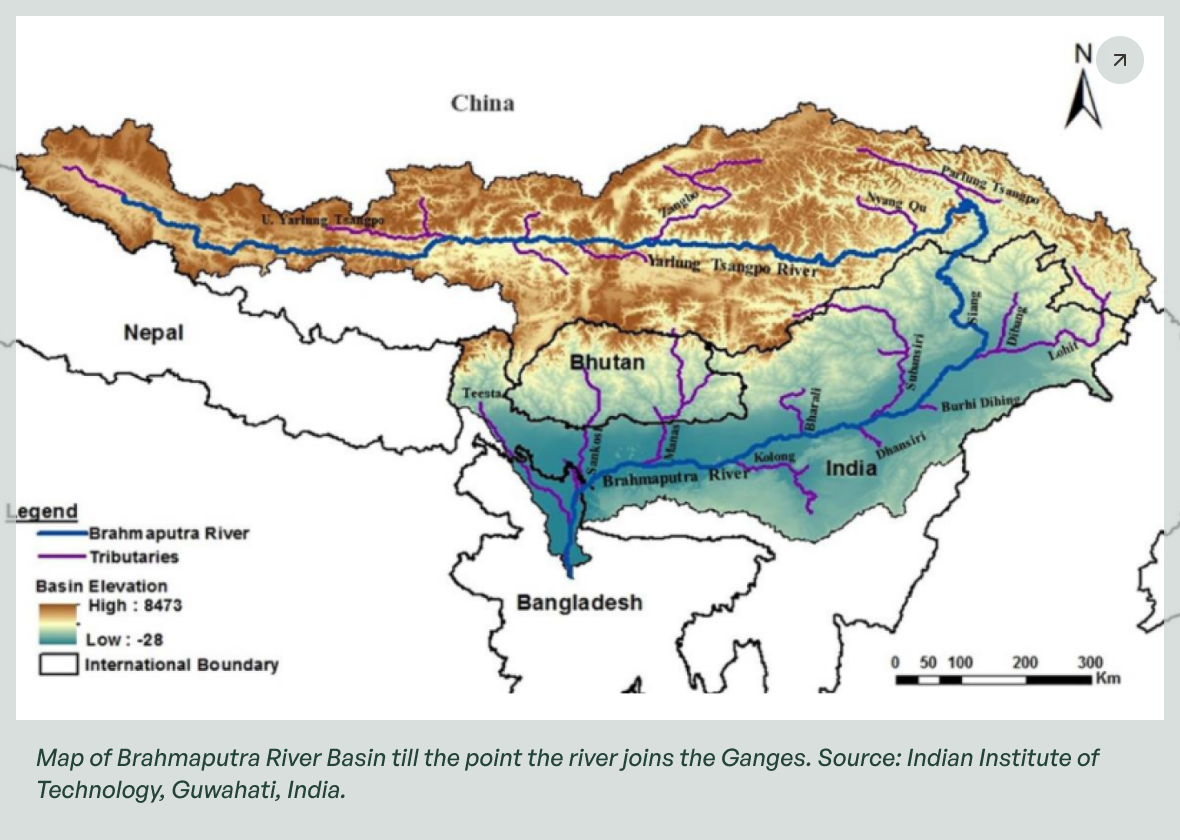Fostering Inclusive Development in the Brahmaputra River Basin: Harmonising Nature Conservation and Human Progress



The transboundary Yarlung Zangbo–Brahmaputra–Jamuna river (henceforth, the Brahmaputra River) originates in the Chemayungdung mountain ranges in China's Tibet Autonomous Region (TAR), flows through India, and joins the Ganges in Goalundo Ghat in Bangladesh (see figure above). The river is a lifeline for many. It provides food, water, and other resources to local communities. It is home to a plethora of wildlife, including the endangered Ganges River Dolphin (Platanista gangetica).
The river, with a total length of 2,880 km in the basin countries, can give a boost to inland water transport. This is critical as water transport is energy efficient and has a low carbon footprint. It helps reduce greenhouse gas emissions as countries strive to meet their targets to achieve carbon neutrality.
There is a bilateral Protocol on Inland Water Transit and Trade (PIWTT) on the Brahmaputra between India and Bangladesh. This protocol was first signed in 1972. It was last renewed in 2015 for five years with a provision for its automatic renewal for a further five years. The PIWTT between India and Bangladesh allows mutually beneficial trade arrangements for the
use of waterways for the movement of goods between the two countries by vessels of both countries along the notified Indo-Bangladesh Protocol (IBP) routes.
Inland water transport is crucial for the movement of goods and passengers across rivers including transboundary rivers. It creates opportunities for regional socio-economic development through trade, tourism, promoting diplomatic ties and cultural exchanges.
But there is a downside. Rivers are often modified to cater to the needs of water transport, and the Brahmaputra is no exception. These minor or significant developments alter the attributes of the river and impair the river ecosystem's functioning.
Importantly, in the Brahmaputra River and its tributaries, water transport threatens the population and habitat of the endangered Gangetic dolphin. Dredgers and vessels create loud underwater noises that adversely affect the dolphins, which depend on echolocation to find their prey. Dredging the riverbed to deepen the navigation channel and keep it silt-free has other effects including on populations of fish on which the dolphins depend. Various waterways' developmental activities affect the dolphins' physiological and psychological health. Studies by the Assam Inland Water Transport Development Society (AIWTDS) and the Bangladesh Forest Department note that the IBP routes along the Brahmaputra River overlap with previous dolphin sighting records across the region. Moreover, with a vision of increasing inland water transport, the intensity of vehicular traffic in the Brahmaputra River is bound to increase. Therefore, given the soaring risks of water transport on the overall river ecosystem and allied stakeholders, a long-term provision for safeguarding nature-society interactions must complement transport strategies.
The question is whether developing inland water transport in the Brahmaputra River Basin is ecologically sustainable. A satisfactory answer to this question will be for inland water transport plans to include environmental protection and consideration of the needs of the people who live along the banks of the river, while such transport brings transformations to the basin. Transformations refer to fundamental changes in socio-technical-ecological systems that lead to new patterns of interactions and outcomes. Transformations are dynamic and often altered under undesirable circumstances to conform to the current reality of interaction between humans and their environment. In this context, transformations through water transport must augment the needs of multiple stakeholders, such as transporters, technocrats, environmentalists, and local community members, for prioritising a consensual understanding of the impacts of inland water transport on nature-society interactions in the Brahmaputra River Basin.
A transformative change is imperative via co-production and using relevant modern technologies to support and accentuate sustainability in the Brahmaputra River Basin. These transformations can bring balance to nature-society interactions in the basin.
In an initiative to bring these transformations to the Brahmaputra River Basin, the Indian Institute of Technology Guwahati (IITG), an institution located at the bank of the Brahmaputra in north-eastern India, has embarked upon a study focusing on the impacts of inland water transport on the Brahmaputra River Basin. The aim is to understand the complex interplay between political, economic, and ecological factors contributing to interactions in the river related to inland water transport. In this context, a two-day workshop was held in New Delhi, India, in April 2023 involving project stakeholders, such as civil society organisations, media professionals, traders, academics, and government and international organisations from India and Bangladesh. The workshop found that stakeholders need to understand the impacts of inland water transport on the river's ecology. It proved pivotal in sensitising stakeholders to transform inland water transport towards ecological sustainability.
The project is part of a larger initiative called Trans-Path-Plan: Water Transformation Pathways Planning, involving eight countries worldwide and is funded by the Dutch Ministry of Foreign Affairs. The future intentions of the project are to highlight the power dynamics prevalent in institutions and policies that can directly or indirectly affect the decision-making processes necessary for effectively balancing the needs of multiple stakeholders to reduce adverse impacts on nature-society interactions. Moreover, IITG, through this project, aspires to be instrumental in expanding the criticality of using modern technology, such as AI-driven monitoring systems, sensors, and early warning systems that can aid in safeguarding aquatic wildlife, specifically dolphins, from the impacts of inland water transport.
Authors & Contributors
